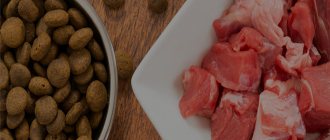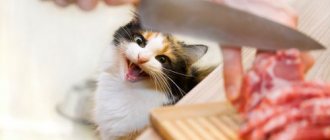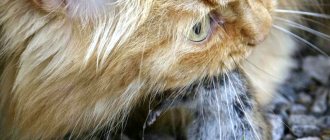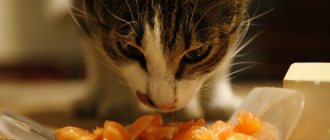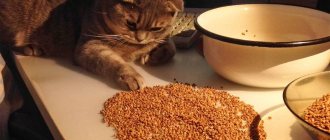The benefits of fish for cats
It is now fashionable to say that cats are absolutely not allowed to fish. But many continue to give it to their pet, rightly believing that thousands of cats have happily lived long lives on a fish diet. And it’s fair to say that such food has a number of advantages.
Complete set of amino acids
Fish is a complete protein of animal origin. It is easily digested in the short intestines of cats and contains essential amino acids, including taurine. Depending on the type of fish, the amount of protein is 16-24%, and it is absorbed by 95-98%, in contrast to meat protein - 87-90%.
Source of Omega-3 Fatty Acids
Unlike humans, it is not lean fish that is healthier for a cat, but fatty fish. In river fish (ruff, perch, pike) the fat content does not exceed 4%, the same amount in pollock, cod, and flounder. Noble varieties of fish contain 9-25% fat: herring, salmon, mackerel, sturgeon. Fat serves as a valuable source of energy and essential Omega-3 acids. Unsaturated fatty acids ensure healthy skin and coat, help reduce inflammation in the joints, and are necessary for the normal functioning of the heart and kidneys. If the cat does not get enough omega-3 acids from food, it is recommended to administer them in the form of dietary supplements (fish oil).
Thus, with fatty fish, the cat receives high-quality protein and the optimal amount of “good” fat. Claims that fish is not a species-specific food for cats are unsubstantiated. In the same way, it is not natural to feed your pet beef or chicken, because in nature a cat would eat a mouse or small bird whole, with head, skin, entrails and bones.
And what should I do with this fish?
Attractive taste and aroma
Many cats love the smell of fish and seafood. You can easily add vegetables to your pet’s food by grinding them together with fish, and even feed the tablet. Using fish juice, they flavor the water, stimulating the cat to drink more - this is necessary for diseases of the urinary system.
Even a small amount of fish in industrial food can make the product attractive to cats - this property has been successfully used, for example, in the production of “unpalatable” food for cats with kidney failure (Renal).
Fish...murrr
In other words, fish is a good way to pamper your cat, diversify the menu, and even encourage desirable behavior (training). But fish can bring not benefits, but great harm to health, if fed incorrectly.
Sardines, ideal for cats with strong joints
Including sardines in our cat's diet will provide her with Omega 3s, which, as we have already said, are ideal for maintaining strong joints and a healthy, shiny coat. In addition, this type of fish oil in a cat's diet strengthens the immune system and helps prevent heart disease. Not forgetting, of course, that cats love any food that includes sardines. We assure you!
© shutterstock
What kind of fish is best to give to cats?
Let’s make a reservation right away - you should choose fish not for reasons of cheapness, but based on what kind of fish will benefit the cat.
Cats should not be given:
- Freshwater fish varieties (carp, roach, bream, crucian carp).
Cannot be fed raw due to the high content of antivitamins and deworming. And even when boiled, it is impossible to get rid of many small bones that are dangerous for your pet. The meat is too lean, there is not enough of it, and the labor costs for such food are not worth it - it is easier to give a piece of chicken.
Small fish caught with a fishing rod are not the best treat
- Sea fish that accumulate histamine and mercury (tuna, mackerel, herring).
The most useful varieties include fish from the salmon family:
- river trout (lives only in clean water, quite fatty, rarely infected with parasites);
- salmon, pink salmon, chum salmon.
If you need a diet with a low amount of fat, then you can give boiled lean fish - hake, cod, blue whiting.
Trout is a good choice
How to cook meat for a cat
To the question of whether a cat can be given raw meat, beef, the answer is yes, but with some conditions. Meat for feeding the animal must first be frozen in the freezer for about two days. This will remove parasites from the meat. Thawed meat should be thoroughly washed and cut into small pieces. Cats are predators; they do not chew their food, but swallow it in pieces; the digestion process itself occurs directly in the stomach. Therefore, the pieces should not be large, two centimeters maximum.
Some experts recommend pouring boiling water over the meat, but this is controversial. After all, in nature, cats hunt and eat raw meat.
If you have doubts about the quality of a meat product or want to diversify your pet’s menu, you can boil it or even stew it. The broth in which the meat was cooked can also be offered to the cat.
How to give fish to cats
More than half of the problems associated with feeding fish can be avoided by boiling the delicacy. When cooked, thiaminase (vitamin B1 antagonist) and trimethylamine oxide (iron antagonist) are destroyed, and parasite larvae are killed.
Before giving fish to a cat, you need to remove fins, bones, and all sharp parts of the carcass. It is not advisable to feed milk or heads separately; they give only meat.
Fish should not be the basis of the diet; it is better to give it as an additional source of valuable substances and delicacies. If your cat eats fish often, you need to take care of additionally including vitamins E, K, and group B in the food.
Fish is an excellent flavoring agent, so many owners use it to disguise cereals or vegetables - the fish is mixed with them in a bowl in the form of minced meat or small pieces.
Let's summarize. In order for fish to be beneficial and not harmful, you should:
- Choose a type of fish;
- Boil for at least 20 minutes (do not add salt to the water!);
- Remove bones (fillet);
- Give no more than 1-2 times a week;
- Make sure your cat is not allergic to fish.
It is strictly forbidden to feed your cat salted, dried, smoked, fried fish or canned food.
The owner needs to be careful that the cat does not develop a dependence on fish - when the pet refuses any other food.
Give me more fish, man!
Salted and fried are prohibited
Consumption, especially frequent, of such a product, which seems completely harmless at first glance, can actually cause total harm to the cat’s health. The huge amount of salts contained has a negative impact on the entire genitourinary system. Dried and dried foods should also be included in the list of prohibited foods for pets. Any such products are strictly prohibited.
Smoked versions are no better, as they hit the liver hard. Scientists believe that as a result of cooking, a large number of carcinogens are formed in the pulp, causing cancerous tumors. This is dangerous not only for animals, but also for humans. This issue has not yet been thoroughly studied, but there is still more harm than good.
When cooked in oil, a fried product is also saturated with harmful compounds. In addition, its calorie content is several times higher than that of raw or cooked foods. Excessive amounts of fat can cause serious disruptions in the functioning of the pancreas and the body's main filter, the liver.
You should also not give fish cooked with seasonings, sauce and other various additives that the owner likes. This will have a bad effect on the furry's health.
If a pet eats such food, a huge amount of electrolytes will accumulate in its body, and the cells will stop working in the correct mode.
Signs of salted fish poisoning:
- vomit;
- lethargy;
- frequent urination;
- dehydration;
- lack of appetite.
This is just a small list; in fact, your pet should never eat salted fish; it can be fatal. In case of poisoning, you must contact a veterinarian and strictly follow his recommendations.
What about dry fish food?
Let's consider the composition of high-quality feeds, in which fish is used as the main source of protein (in cheap feeds, fishmeal acts only as a flavoring agent).
- Acana Pacifica: used whole herring, sardine and flounder (whole carcass with bones and giblets), whole sea bass and hake, cod fillet. The fat content of the feed is 20%, the calcium to phosphorus ratio is 1.4:1, choline chloride (vitamin B4) and vitamins K and E are added additionally.
- Now Natural Fish Adult Recipe: component No. 1 of trout fillet, additionally enriched with many vitamins, minerals and individual amino acids. 19% fat, phosphorus content is significantly less than in Akan.
- Aatu Cat Salmon&Herring: salmon fillet and whole herring. Vitamins A, D, E, iron, zinc, manganese and amino acids – additionally. 18% fat, calcium to phosphorus 1.3:1.
These foods are safe for cats because:
- no injuries from fish bones;
- the fish has been heat-treated - there are no parasites or substances that destroy vitamins;
- the balance of calcium and phosphorus is maintained;
- a large amount of animal protein maintains the acidic environment of urine, which is the best prevention of urolithiasis;
- vitamins and microelements are added additionally or at the expense of other feed components.
The only threat that remains open is the toxins contained in marine fish. The mercury content in animal feed should be controlled, but it is difficult to say whether this is actually the case. Owners should avoid constant use of dry and wet tuna-based food, as it is the leader in the content of heavy metals.
Why do cats love fish so much?
Most felines hate water, so their innate love for fish seems very strange. According to felinologists, humans are to blame for this.
Scientific explanation
There are very few fishing cats that hunt in open waters. Most of the famous breeds became acquainted with fish thanks to people who decided to share their catch with their pets.
Opponents of this method of feeding argue that it is not natural. But the same can be said about chicken and beef, because cats primarily hunt rodents and birds. Getting their meat at home is quite problematic, so when preparing a diet, the emphasis is on the amount and benefits of proteins and fats, and not on the sources of their production.
INTERESTING!
The number of taste buds in cats is less than in humans (473 versus 9000). But their sense of smell is 2 times greater than ours. Because of this, they are attracted to foods with strong aroma.
What fish do cats like most?
It all depends on taste. A pungent aroma attracts attention, but is not always attractive. On the contrary, it repels some animals - so you should not insist on changing your usual diet if your mustachioed pet runs away from a new dish in fear or mannerly buries it right before your eyes.
In addition to taking into account individual preferences, focus on safety. The minimum amount of heavy metals is typical for marine varieties from the salmon family: chum salmon, pink salmon, sockeye salmon and salmon.
It also makes sense to pay attention to cod, hake and whiting. They have a low fat content and are suitable for older cats and pets on a diet.
“ So: chum salmon, pink salmon, sockeye salmon, salmon, hake, blue whiting and cod.
How to diversify your cat's diet
You cannot feed your cat only meat and meat products. It is very useful to supplement his diet with a variety of cereals (rolled oats, buckwheat, rice, millet). You need to boil porridge in water, although you can use broth from lean meat. Experts recommend adding a little natural vegetable oil to this mixture, this improves the functioning of the animal’s intestines.
Low-fat fermented milk products are also beneficial for domestic cats - yogurt without additives, kefir or sour cream with a fat content of no more than 9%. Contrary to popular belief, milk is absolutely not healthy for cats, and sometimes even harms digestion.
For your pet’s well-being, it is better not to mix meat and dairy products, for example, give porridge with meat and vegetables at lunch, and a bowl of low-fat yogurt or yogurt in the evening.
Cats love domestic eggs, but they should not be given in large quantities either; excess protein can lead to health problems. A raw quail egg can be offered to the cat as a whole, but only the yolk can be given from a boiled chicken egg.
Is it possible to give raw meat to a cat, and what should it be combined with? Vegetables are great. Your pet's diet can be quite varied. If taught from an early age, the cat will eat boiled vegetables (beets, carrots, cauliflower, zucchini) well. They are mixed with meat or boiled fish.
However, there are quite serious restrictions on mixing feed and natural nutrition.
Gobies
Many people deliberately buy bulls for their cats, which they even give them raw. At the same time, no one thinks about the fact that this fish lives in polluted waters, which is why it often comes to the pet already infected with a variety of parasites, which are not at all harmless to its health.
In addition, a rare owner, pampering his cat with raw bulls, thinks about hard bones, which can even harm the pet. By the way, the same can be said about sprat, which some people love to buy for cats in order to pamper them with tasty and “healthy” food.
